Menu
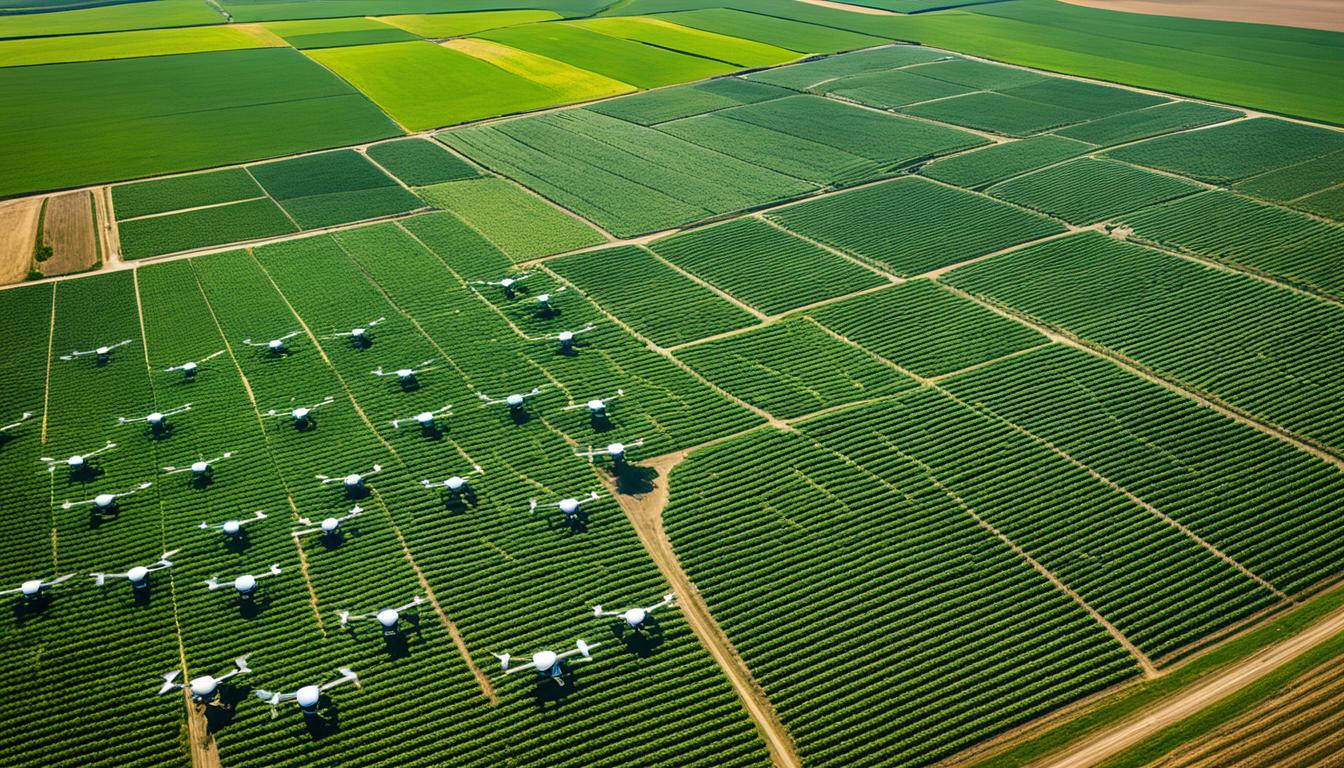
“The best way to predict the future is to create it.” This quote by Peter Drucker is very relevant to farming today. The introduction of agricultural drones is changing the way farming works. It brings together precise agriculture, crop management, and eco-friendly farming into a new, creative future.
In recent years, drone technology in farming has grown a lot. It helps with the tough tasks that farmers face today. In 2019, this market was worth $1.2 billion. By 2024, it’s predicted to grow to $4.8 billion. This fits well with the move towards precise agriculture, which focuses on understanding and responding to field differences.
Drone tech is great for things like watching crops and applying treatments accurately. This makes it a vital tool for better harvests and being eco-friendly. But, rules that control drones have slowed down their use, especially for small farms and new farmers. In the U.S., if these rules ease up, it could bring over $82 billion in growth, and create about 100,000 jobs in the drone sector by 2025.
Drone technology in farming has come a long way since the early 2000s. Back then, drones were simple tools for taking aerial photos. Today, they use advanced data analysis to enhance farm operations. This has led to a big growth in the market, now valued at an estimated $4.8 billion for 2024.
At first, drones were mainly used to map and survey farmlands. As technology improved, they became vital for many tasks on the farm. Now, drones with high-quality cameras and sensors offer super-precise images. This helps farmers make very accurate decisions.
More and more farmers are using drones. In South Korea, about 30% of all farming sprays are done by drones. The benefits are clear, like better yields and savings on labour costs. For example, with ten drones, two people can plant 400,000 trees per day. That’s huge!
Today, new drone tech trends are game-changing. Drones can now use artificial intelligence and learn about different crops and how they’re planted. There’s also research on using drones for better irrigation, which checks soil health. The market is growing fast, all to boost efficiency and precision in agriculture.
Drone sprayers have become a popular choice, making spray applications precise and saving money. There are even plans for drones that can pollinate by themselves. These changes are not just making farming better but also supporting it to be more sustainable.
In today’s world, drones revolutionise the farming sector. They provide cost-effective solutions that greatly enhance efficiency and productivity. These benefits are changing how farming is done across various operations.
Drones bring a new level of efficiency to farming. They cover large areas quickly, accomplishing tasks that used to take days in one flight. This fast data collection supports quick decisions and actions, vital for crop and livestock health. Drones with thermal cameras can even watch the animals’ temperatures. This helps spot and tackle health issues early.
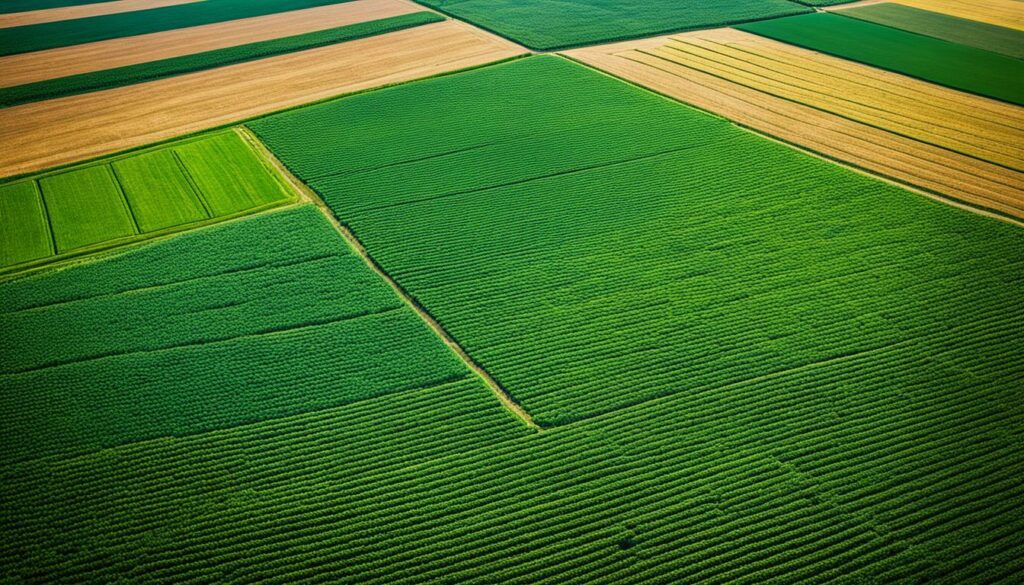
Using drones can lower the work needed from human hands. Farmers spend less time and effort on tasks such as monitoring and maintenance. Drones handle spraying, seeding, and checking plant health efficiently. This move towards automation means big savings for farmers. Moreover, drones can spray exactly where needed, cutting down chemical use and waste.
Drones help farmers achieve better crop yields. They provide detailed images and instant data, so problems can be fixed right away. This approach leads to healthier crops and higher yields. Improved manure management, precise planting, and pest control play key roles in increasing farm profits.
| Year | Market Value (in billions) |
|---|---|
| 2020 | $1.2 |
| 2025 (Projected) | $6 |
The results are clear. Drones are at the forefront of farming’s future, driving efficiency, sustainability, and profits. Farmers adopting drones see improvements in productivity and the bottom line. This makes a strong case for their use in agriculture.
Precision agriculture is all about using technology to farm better, making things efficient and eco-friendly. Drones have changed the game, becoming key in modern farming.
Precision agriculture means using high-tech tools to closely watch and manage crops. The aim is to do everything just right, from planting to taking care of the plants. This way, farmers can be super precise, helping crops grow well and reducing waste.
Drones are essential in precision agriculture. With top-notch sensors, they gather real-time info from above. This info could be about how the crops are doing, the soil, or if there are any pests.
For this, drones like ones using the Würth Elektronik Evaluation Board for the WSEN-ISDS Sensor are perfect. They ensure drones work at their best. The board includes a 3-axis gyroscope and a 3-axis accelerometer, giving accurate data. It matches the needs of different types of farms, making them even more efficient.
The board also connects easily with many devices, which is great for all kinds of farming tasks. Drones can be used to plant seeds, check crops, examine soil, and help with watering. This flexibility is key in smart farming.
In Rwanda, drones are making a big difference. They collect detailed info about the crops and soil. This helps farmers decide where and how much water and fertiliser to use. These smart choices lead to better use of resources and more crops.
Drones are also changing how pigs are bred in Rwanda. They help by delivering pig semen. This boosts pig farming and helps farmers. These improvements are part of a bigger plan in Rwanda to grow agriculture in a smart and sustainable way.
Drones are making a big difference in farming today. They are especially useful for checking plant health. With high-tech tools like Normalized Difference Vegetation Index (NDVI), they give farmers a really close look at plant health. This tech is great because it helps spot problems early. So, farmers can act quickly to fix them.
Drones are super efficient. They can check large areas in a short time. A drone can cover up to 500 acres in one day. This is much faster than the old, slow ways. It can save about 90% of the time.
These flying machines take excellent pictures and provide data immediately. This means farmers can look at big fields quickly. They can fly over fields many times, improving how well they gather data. The detail in drone pictures is so good that problems in the plants can be seen and fixed very fast.
One big plus is that drones help use chemicals better. They only put chemicals where they are needed, not everywhere. This careful use can lower chemical use by up to 30%. It’s good for the wallet and the planet. Fewer chemicals mean less pollution and fewer greenhouse gases.
The market for farming drones is growing fast. In 2019, it was worth $1.2 billion. By 2024, it’s expected to be $4.8 billion. And by 2025, it might even hit $6 billion. Some say the market could grow to $18.22 billion by 2030. This shows how important drones are becoming in farming.
Farms are finding new ways to use drone tech. For example, they’re looking into using drones for pollination and improving how they watch crops with AI. Checking plant health with drones is now key to managing farms well. It helps farmers get more crops and make more money.
| Advantages of Using Drones | Impact Metrics |
|---|---|
| Efficiency in monitoring | 90% time-saving, covering up to 500 acres per day |
| Precise plant health assessment | Millimetre-level accuracy |
| Reduced chemical usage | 30% reduction, lowering environmental impact |
| Market growth | $1.2B in 2019 to $18.22B by 2030 |
Drone technology is changing agriculture fast, especially in crop spraying. By using drone sprayers, we make farming more efficient and safe. Drones spray chemicals evenly and accurately, which leads to less waste and harm to the environment.
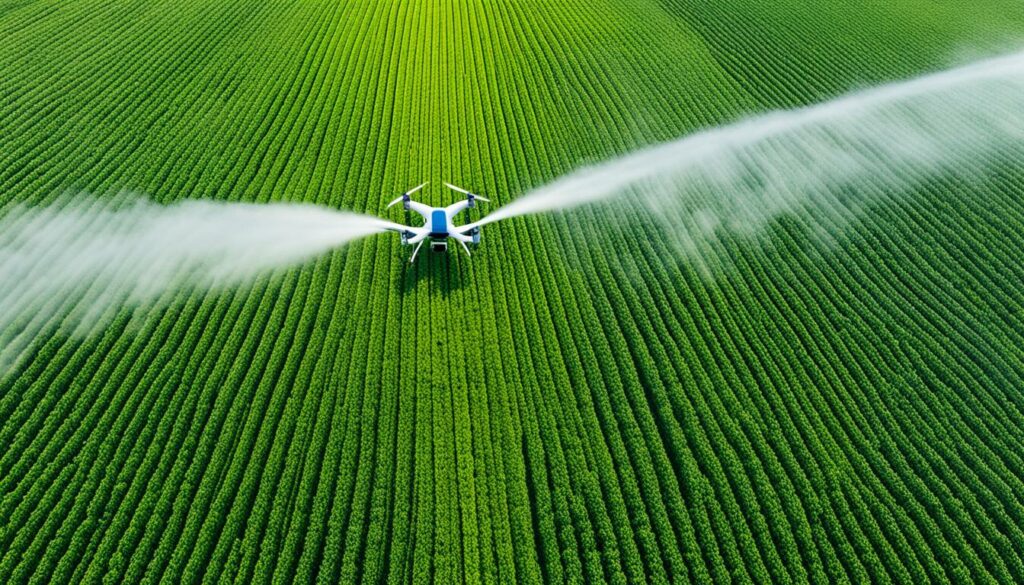
Drone tech reduces the problems farmers often face. These sprayers cover big areas quickly, cutting down on labour costs and boosting productivity. They use precision farming to improve crop yields by up to 5%.
These drones use advanced sensors for better coverage, making their work more effective and efficient.
In Vietnam, the XAG P100 was used on banana and durian farms. It saved a lot on water, pesticides, and fertilisers. Plus, it made farming safer by reducing chemical exposure. This shows how drones can really change farming for the better.
Drone sprayers keep farming safer, especially in places like South-East Asia. Here, they replace the need for workers to carry dangerous backpack sprayers through fields. Automating this step cuts down on harmful chemical contact, reducing health risks.
Their fine spray also means less chemical is used, promoting sustainable farming practices.
There’s also a big economic upside. The market for agricultural drones is set to grow from $1.2 billion in 2019 to $4.8 billion by 2024. This means both farming and the planet can benefit from these technologies.
| Country | Drones Used in Agriculture | Benefits |
|---|---|---|
| South Korea | 30% of agricultural spraying | Increased efficiency, reduced labour risks |
| Japan | 40% of rice crop spraying | Enhanced precision, cost savings |
| Vietnam | XAG P100 case study | Substantial reduction in chemical usage, improved safety |
In the future, modern farming technology changes the game for farming. At the vanguard are drones. They help in many farming tasks with great accuracy and efficiency.
The agricultural drones market is set to be worth more than £5 billion, showing their big role in farming’s future. At first, drones were just for precise crop farming. Now, they also watch over livestock closely. They use sensors, cameras, and GPS to track cattle’s health, movement, and to find lost animals.
Drones do better than people just watching. Their precision helps farms be more productive and make more money. They save farmers a lot of time and money by doing tasks quicker than people.
But drones also help the planet. They produce less pollution than big farm machines and use pesticides more carefully. For example, drone spraying uses much less herbicide than older methods.
Drones doing precise and green jobs show the future of farming. They keep getting better with new tech and using AI. This progress is important, though some people might not be ready to change or find drones expensive.
There are also innovations for animals. Like smart cow collars. These collars spot when a cow is sick early, helping farmers to care for their animals better. They have been in use since 2010, in countries like Scotland, for things like tracking fertility and health checks.
Looking ahead, modern farming tech will keep moving forward. It will make farming more precise, efficient, and kind to the planet.
Drone technology in farming is bringing huge economic benefits. These tools help farmers save money and earn more from their investments. Drones are making a big difference by improving how work is done and reducing wasted resources.
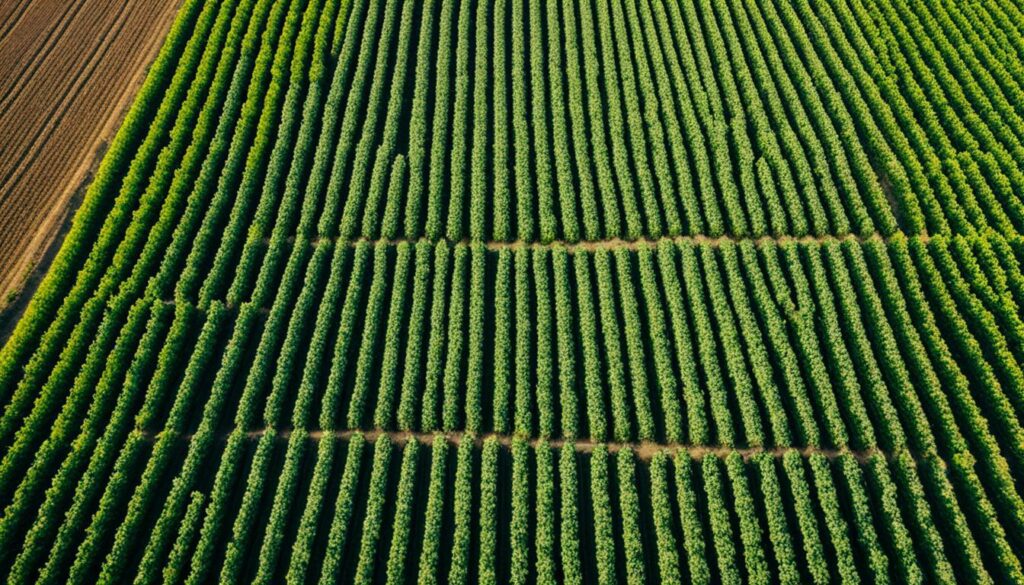
Drones are cutting down the need for manual work, lowering costs. In Bihar, India, a drone can cover a lot of land in just 8-9 minutes. This is much faster than the 7-8 hours a person takes. South Korea shows that using drones for spraying 30% of crops can save a lot of time and money.
Drone sprayers reach places that are hard for people to get to. This means less chemical waste and less runoff, saving even more money.
Spending on drones for farms is a smart move with large profits expected. The market for agricultural drones is growing fast, from $1.2 billion in 2019 to $4.8 billion by 2024. Using drones for careful spraying can increase crop yields by 5%.
This careful work also means crops are less likely to be damaged, making them better quality. Drones with special cameras and sensors can help figure out how to get the best from the land. In Nigeria, they use drones to map out and check the soil.
| Country | Usage | Economic Impact |
|---|---|---|
| South Korea | 30% agriculture spraying | Reduces labour and chemical costs |
| India | Faster field coverage | Labour efficiency |
| Nigeria | Soil analysis via spectrometers | Optimised crop yields |
The impact of drones on farming is game-changing. By using drones in agriculture, farms can make more money and help the planet at the same time.
Unmanned Aerial Vehicles (UAVs) are key in today’s farming. They cover many aspects of farm management. This use makes farming more efficient and based on detailed data. We’ll see how UAVs are changing agriculture in different ways.
Field mapping with UAVs is changing agriculture significantly. With high-quality cameras, like those used by Taranis, they can take detailed images of fields. Images are taken every 10 to 12 days. This allows for very detailed information about the crops’ health and the field’s conditions.
This constant monitoring helps farmers make smart choices about planting, watering, and fighting pests. As a result, they can get better yields.
UAVs are also great for looking at the soil. They can find out what nutrients are lacking and how much moisture is in the ground. This is done with special sensors on the UAVs.
The company Taranis does this for around $10-18 per acre. This makes it affordable for many farmers. This precise way of looking at soil helps farmers really target where they need to add nutrients or water.
Drones help with livestock management too. They can keep an eye on where the animals are. This makes sure they stay in good health and the right pastures.
This technology saves time and means fewer people are needed for these tasks. It also lets farmers react quickly to things like animals getting lost or checking how good the food is.
Using drones this way helps farms run better and more sustainably.
Drone sprayers are changing how we grow crops, especially in tough places. Places like South Korea have seen big changes in how they manage their fields using drones.
One key benefit of drones is that they spread treatments evenly. This means crops get the care they need in a way that’s healthier for people. Manual work in risky areas isn’t needed, making things safer for farmers.
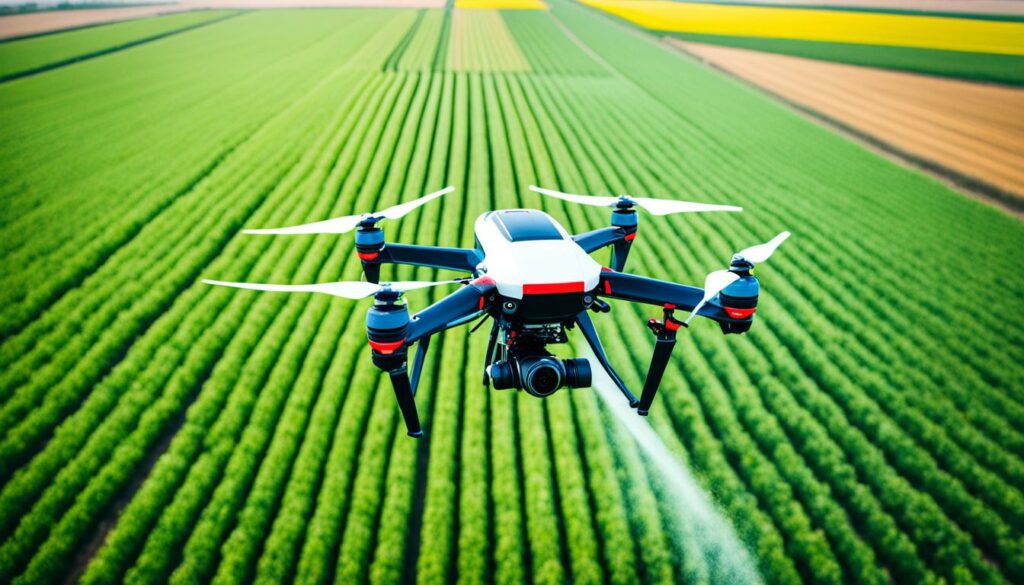
Drones are super fast and accurate. They work over big areas with less water and fewer chemicals. Drones can apply treatments 50 times quicker than backpack sprayers. They use up to 90% less water, which is crucial in dry places.
Companies like BASF are working to bring drones to more farmers. BASF’s programme in Latin America wants to give 8,000 farmers drone tech in five years. They also aim to help improve 400 million hectares of farmland with digital solutions.
Drone technology is set to become a big part of farming around the world. It will help farms be more efficient and kinder to the environment. These changes show a big improvement in how we grow food and look after our land.
| Country | Crop Area Covered (Acres) | Water Usage Reduction | Efficiency Improvement |
|---|---|---|---|
| South Korea | 150 | 90% | 50x Faster |
| Vietnam | 200 | 85% | 45x Faster |
The use of agricultural drones faces several challenges. These include meeting regulations, dealing with technical issues, and handling the costs. Overcoming these obstacles is crucial for drones to be widely used in farming.
Complying with drone-related rules is tough for farmers. The rules can differ by area and require specific permits. They also need to follow flight limits and safety rules. Not following these rules can lead to fines and legal troubles, making it hard for drones to be used well.
Technical problems are a big hurdle too. Drones are improving, but they still have issues like short battery life and small cargo space. They also need better AI for recognising different crops. This means sometimes farmers still have to check on some crops themselves.
The high cost is another challenge for some farmers. Buying the drones and the technology can be very expensive. This is especially hard for small or rural farmers. The costs continue with maintenance and the need for training, making it a significant barrier to entry.
However, the agricultural drone market is set to expand a lot. It’s expected to grow from $1.2 billion in 2019 to $4.8 billion in 2024. This shows the need to tackle these challenges head-on. Solutions like financial aids and technology improvements can help. So can making the regulations clearer and offering more training to farmers.
| Challenges | Details |
|---|---|
| Regulatory Issues | Compliance with aviation laws, obtaining permits, region-specific flight restrictions, and safety protocols. |
| Technical Limitations | Battery life, payload capacity, and the effectiveness of AI in recognising diverse crops. |
| Cost Barriers | High initial investment, operational costs, maintenance, and training requirements. |
Drones are making big changes in farming all around the planet. Farmers from Asia to Australia are using drones to improve their work. Let’s look at how drone tech is helping agriculture in different places.
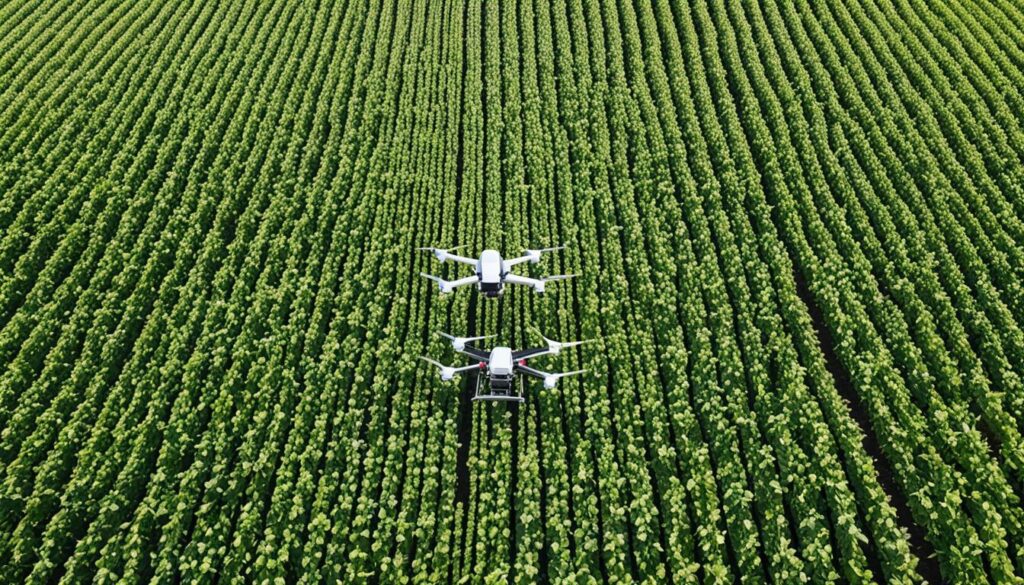
South Korea uses drones for about 30% of their agricultural spraying. This method is much more efficient, getting to tough spots easily. It’s also safer for farmers because they handle fewer chemicals directly.
Thanks to drones, farmers can plan their work better. This boosts their crop yields by up to 5%. So, drones are a big win for everyone involved.
In California, vineyards are a great example of drone use. They use drones to check on their crops and apply things to them. With detailed aerial surveys, vineyards know more about their grapes. This lets them fix issues quickly to get better quality and more grapes.
These successes in viticulture show how well agriculture and drones can work together.
In Australia, drone tech is used for smarter watering and watching crops in real time. The drones figure out exactly how much water fields need. This smart watering helps crops get what they need to grow, using less water.
This approach improves the crops and how water is used. It’s a great step towards better farming for the planet.
These stories show the great things drones are doing for global farming. They help farmers be more precise, reduce waste, and farm in ways that are good for the earth. Drones are changing farming for the better.
| Region | Application | Impact |
|---|---|---|
| South Korea | Agriculture Spraying | Increase in efficiency and safety; 30% of spraying conducted via drones. |
| California | Vineyard Monitoring | Optimisation of resources, improved yield quality and quantity. |
| Australia | Wheat Farm Irrigation | Efficient water use, enhanced crop growth. |
Agricultural drones are changing how we monitor crop health. They use advanced tech like NDVI and real-time data. This makes farming more precise and efficient. It ensures healthy crops and the best yield possible.
NDVI is key in farming to check on crop health. It looks at how much light plants take in and reflect. With this, we can see how well or stressed plants are. Then, farmers can act fast to help their plants grow better.
Drones are great at collecting data quickly. They can take up to 4000 pictures in one flight. This data, turned into maps with software like Pix4D, helps farmers know what their crops need right away.
Drones can also gather info on plant, soil, and water health. Some drones are so accurate, they can measure details up to 1cm. This precision helps farmers take very good care of their crops.
Drone models like the DeltaQuad Evo and the DeltaQuad Pro #MAP are leading this change. The DeltaQuad Evo flies for 4.5 hours, covering a lot of ground. The DeltaQuad Pro #MAP scans up to 50km in tough weather, showing how reliable drones are.
These drones can use top cameras and sensor technology. This makes their mapping very accurate. It helps a lot in keeping an eye on crop health.
| Drone Model | Flight Time | Mapping Capabilities | Weather Adaptability |
|---|---|---|---|
| DeltaQuad Evo | 4.5 Hours | Vast Areas | Standard Conditions |
| DeltaQuad Pro #MAP | 110 Minutes | Corridor Scans up to 50km | Adverse Conditions (rain/snow) |
Drones are making farming more precise and kind to the environment. By using data from drones, farmers can tailor their care for crops. This means better crop health and higher yields, showing the key role drones play in farming.
Drones are making big changes in farming for the better. They help in making farming more eco-friendly and efficient. This is great news for the environment.
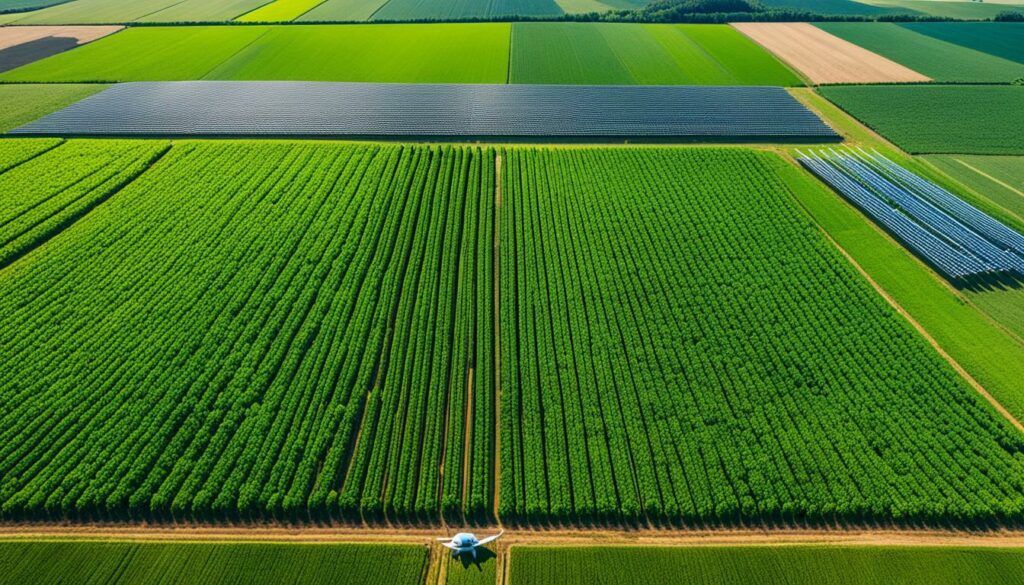
Drones do a fantastic job in applying chemicals, like fertilizers and pesticides, right where they’re needed. This means less chemicals are used and less harm is done to rivers and lakes. By using sensors, drones can check the soil and crops. This helps farmers use the perfect amount of chemicals. Less waste means healthier crops.
Sustainable farming gets a big boost from drones. They check the soil and treat it, keeping it in top shape. A healthy soil means better crops without too many chemicals. For example, drones use special cameras to spot when crops need more nutrients. Then, farmers can add the right nutrients at the right time.
Drones can also quickly scout over large fields. This helps catch problems early. Fixing issues fast makes farming more efficient. It also helps meet big goals like the U.K.’s plan to have carbon neutral farming by 2040.
By using drones, farmers can do their part in fighting climate change. They can prevent a 16% crop loss in Europe by 2050. This way, we can have farming that is good for nature and the people who depend on it.
Artificial intelligence (AI) is making big changes in farming, especially with drones. Thanks to advanced AI, drones can do much more than before. They can now handle complex tasks using smart algorithms.
Machine learning is boosting what drones can do in farming. With AI, drones can process huge amounts of data live. This means farmers can make very accurate decisions quickly. For example, by using NDVI images, drones can check plant health and spot pests with high precision.
AI-powered drones are changing how we look at crop variety. They give precise reports on different plant types in the same area. This helps plan better care for every crop. In the end, it promotes a healthier mix of plants and helps the land.
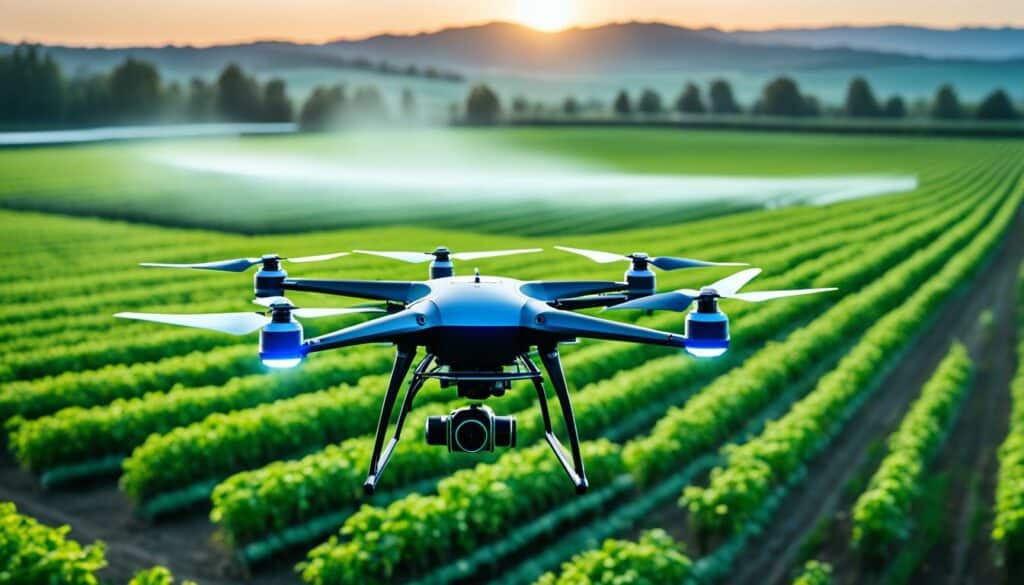
The future of AI in farming looks very promising. With more AI progress, drones might work fully on their own. They could do detailed farming jobs without people. Already, countries like the Netherlands and Japan are working on drones to help crops grow by themselves. Drones could also get better at seeing different plants, which would be useful in many farming situations.
To fly agricultural drones, you need special training and skills. This ensures you use them well and safely. The first step is getting an FAA Part 107 Drone Pilot License. This is a must for anyone who flies drones for business in the United States. It shows you know the basics about flying, can pass a test, and are safe to fly.
If you plan to use drones to spray chemicals, you also need the FAA Part 137 License. It’s about special rules for applying chemicals from the air. Safety and looking after the environment are big parts of this. If your drone is over 55 pounds, you’ll need permission not to follow some Part 137 rules. This special permission asks you to prove your drone is safe and works well.
Getting a state-specific Aerial Commercial Applicator License is also important for drone operators. You need to finish a training course and pass a hard test. You also must show you’re good at flying the drone, have insurance, and stick to environmental rules.
Learning to fly a drone is not just about the controls. It’s about lots of things, like data analysis and keeping the drone in good shape. For new pilots, groups like Fair Lifts Unmanned Aerial Services offer help. They can guide you through getting the right licenses and show you how to use a drone for farming.
But it doesn’t stop there. You always need to keep learning. Good training teaches you both in the classroom and out in the field. You learn everything from knowing the air rules to exactly where to use treatments. It’s vital you can understand data to make smart choices that help with farm work.
In summary, becoming an agricultural drone pilot takes a lot of work. You must work hard to get the right certifications and keep learning. This is how you stand out in the drone farming world. It shows you’re serious about being good at what you do and following the rules.
Drone technology is pushing farming forward, making it more efficient and green. The market for these drones is growing fast, from $1.2 billion in 2019 to a predicted $4.8 billion in 2024. Drones can boost crop yields by up to 5%, which is a big reason to use them more.
However, there are hurdles to clear, like tough rules, high costs, and the need for education. Using drones can be tricky for farmers because of these challenges. But, more education and training are now available to help solve these problems and make drone use easier in farming.
The future of farming with drones looks promising, especially when AI and drones team up. Drones will keep getting better, with smarter AI and easier ways to use them. This progress is leading to a new age of super-precise farming that boosts both efficiency and environmental care.
Drone use in farming started with simple aerial photos to check on land. Now, drones have grown to use big data to help farms make better choices.
The use of drones in farming has quickly grown. In 2019, the market was worth
Drone use in farming started with simple aerial photos to check on land. Now, drones have grown to use big data to help farms make better choices.
The use of drones in farming has quickly grown. In 2019, the market was worth $1.2 billion. By 2024, this is likely to grow to $4.8 billion. This growth is because drones can make farming more precise and efficient.
Now, drones are being used for checking soil health, monitoring crops with AI, and doing deep data analysis. These trends show that farming is moving towards more smart and precise methods.
Drones can fly over big parts of land quickly, speeding up jobs like keeping an eye on crops or spraying them. This means farms can be more efficient overall.
Drones can do many tasks that people used to do by hand, like checking crops or spraying them. This means farms need fewer workers, reducing costs and making jobs safer.
By giving farmers detailed, up-to-date info, drones help them make better choices. This can boost crop health and yield.
Precision agriculture aims to use data for exact crop care. It’s all about making farming more productive and eco-friendly.
Drones are key in precision agriculture. They collect data and images that help farmers not waste resources and manage crops better.
Drones with special cameras can quickly scan big areas for crop problems. This lets farmers act fast to keep their plants healthy.
Drones can fly over fields to spray treatments evenly. This automates a big job, saving time and making farming more efficient.
**A:** In Vietnam, the XAG P100 drone helped with bananas and durians. It used less water, pesticide, and fertiliser. Plus, it kept farmers safe from harmful chemicals while showing how useful drones can be.
Drones make farming safer by doing tasks that could harm workers, like spraying crops. This boosts health and safety for farmers.
Using drones saves money by making crop care more efficient. It cuts waste and improves earnings, making it a good investment.
UAVs help with detailed field maps, soil checks, and keeping track of animals. This info makes for better decisions and smoother farm work.
Drone sprayers are making crop care more precise, even in hard-to-reach areas. They save resources and make working the land safer without needing people to apply treatments by hand.
There are challenges like meeting rules, dealing with drone limits (like short battery life), and the high cost of getting started with drone technology. Overcoming these hurdles is important to using drones more in farming.
**A:** In South Korea, drones do about 30% of the spraying work. Places like California’s vineyards and Australia’s wheat fields have also seen good results, making their crops healthier and more efficient with drones.
By using advanced cameras, drones look at crops in detail and in real time. This helps farmers act quickly to manage crop health better, leading to better harvests.
Drones make treating crops very precise, which helps the environment by not using more chemicals than necessary. This smart approach makes farming methods more sustainable in the long run.
AI helps drones do a better job at understanding different crops and farming needs. This leads to more advanced, effective, and self-sufficient farming methods.
**A:** To fly and use drones on the farm, you need to know how drones work and what they’re used for. You also need to be good at collecting and using data safely and effectively.
Now, drones are being used for checking soil health, monitoring crops with AI, and doing deep data analysis. These trends show that farming is moving towards more smart and precise methods.
Drones can fly over big parts of land quickly, speeding up jobs like keeping an eye on crops or spraying them. This means farms can be more efficient overall.
Drones can do many tasks that people used to do by hand, like checking crops or spraying them. This means farms need fewer workers, reducing costs and making jobs safer.
By giving farmers detailed, up-to-date info, drones help them make better choices. This can boost crop health and yield.
Precision agriculture aims to use data for exact crop care. It’s all about making farming more productive and eco-friendly.
Drones are key in precision agriculture. They collect data and images that help farmers not waste resources and manage crops better.
Drones with special cameras can quickly scan big areas for crop problems. This lets farmers act fast to keep their plants healthy.
Drones can fly over fields to spray treatments evenly. This automates a big job, saving time and making farming more efficient.
**A:** In Vietnam, the XAG P100 drone helped with bananas and durians. It used less water, pesticide, and fertiliser. Plus, it kept farmers safe from harmful chemicals while showing how useful drones can be.
Drones make farming safer by doing tasks that could harm workers, like spraying crops. This boosts health and safety for farmers.
Using drones saves money by making crop care more efficient. It cuts waste and improves earnings, making it a good investment.
UAVs help with detailed field maps, soil checks, and keeping track of animals. This info makes for better decisions and smoother farm work.
Drone sprayers are making crop care more precise, even in hard-to-reach areas. They save resources and make working the land safer without needing people to apply treatments by hand.
There are challenges like meeting rules, dealing with drone limits (like short battery life), and the high cost of getting started with drone technology. Overcoming these hurdles is important to using drones more in farming.
**A:** In South Korea, drones do about 30% of the spraying work. Places like California’s vineyards and Australia’s wheat fields have also seen good results, making their crops healthier and more efficient with drones.
By using advanced cameras, drones look at crops in detail and in real time. This helps farmers act quickly to manage crop health better, leading to better harvests.
Drones make treating crops very precise, which helps the environment by not using more chemicals than necessary. This smart approach makes farming methods more sustainable in the long run.
AI helps drones do a better job at understanding different crops and farming needs. This leads to more advanced, effective, and self-sufficient farming methods.
**A:** To fly and use drones on the farm, you need to know how drones work and what they’re used for. You also need to be good at collecting and using data safely and effectively.